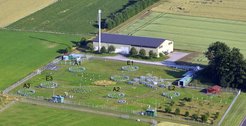Belowground microbiota in temperate grassland

Aerial photo of the Giessen free-air CO2 enrichment (GiFACE) site. Starting from May 1998, three plots (E1-E3) receive CO2 at +20% above the ambient CO2 concentration for year-round during daylight hours. The three remaining plots serve as controls (A1-A3). Aerial photograph provided by Thomas Wißner (© 2013).
The sharply rising level of atmospheric CO2 is one of the greatest environmental concerns. Within the framework of the LOEWE Research Cluster FACE2FACE, we investigated the impact of elevated atmospheric CO2 on the rhizosphere microbial communities in semi-natural grassland (Bei et al., 2018). Study site was the Environmental Monitoring and Climate Impact Research Station Linden, where the Giessen Free Air Carbon dioxide Enrichment (GiFACE) experiment is located (Figure).
Started in 1998, GiFACE is presently the oldest running long-term FACE facility in Europe. The facility simulates a 20% increase above the atmospheric CO2 level that has reached 400 ppm. The elevated CO2 (eCO2) level of 480 ppm is expected in the second half of the 21st century. Thus, the long-term exposure to 20% above ambient CO2 continuously for 20 years suggests a realistic ecosystem response to eCO2.
We used metatranscriptomics to gain insights into eCO2 effects on the biota activity simultaneously across all three domains of life (Archaea, Bacteria, Eukarya). Bulk soil, rhizosphere soil, and roots were sampled in August 2015 and August 2017. Significant eCO2 effects on the composition and activity of the rhizosphere biota (both in soil and on roots) were observed in 2015. No significant effects were observed in 2017. The year 2015 was characterized by the second hottest summer recorded in Europe (following 2003), while the summer temperatures in 2017 were close to the long-term average. As a consequence, the average soil temperature prior to sampling was 4°C higher in August 2015 compared to August 2017. In 2015, the SSU rRNA and mRNA abundances of Eukarya relative to Bacteria were significantly decreased under eCO2. The combined effect of eCO2 and warming was primarily related to a significant abundance increase in Actinobacteria and decrease in Fungi. The decrease in fungal SSU rRNA abundance was confirmed by quantitative RT-PCR. The decrease in fungal abundance was most pronounced for Ascomycota, Basidiomycota and unclassified fungi, while relative to the other fungal groups, the abundance of Glomeromycota (arbuscular mycorrhiza) was increased under eCO2. In addition to fungi, Amoebozoa, SAR group and Metazoa decreased, while Acidobacteria and Planctomycetes increased in abundance under eCO2. In summary, our metatranscriptomic study showed that, in combination with extreme weather events, moderately elevated CO2 as expected in the second half of the 21st century can have tremendous effects on the rhizosphere biota in grassland in summer. In Central Europe, such extreme weather events are predicted to increase in frequency and intensity in the next decades.
More recently, we studied the impact of winter-summer change of seasons on structure and function of the belowground microbiota. Seasonal change had nearly no effect on the taxonomic composition of the rhizosphere microbiota, although its community size was increased fivefold in summer. Seasonality, however, had a major impact on taxon-specific gene expression. The relative transcript abundance of 668 genes significantly differed between winter and summer samples. Acidobacteria, Bacteroidetes, Planctomycetes, and Proteobacteria showed a greater relative gene expression activity in winter, while mRNA of Actinobacteria and Fungi was, relative to other taxa, significantly enriched in summer. In winter, greatest transcript levels were observed for stress-responsive genes known to encode proteins that efficiently protect microbial cells against freezing damage, such as GroEL and Hsp20. Various differentially abundant transcripts encoded glycosyl hydrolases (GHs). The production of transcripts encoding carbohydrate-active enzymes (CAZymes) of GH36 family was significantly increased in winter, while those encoding CAZymes of GH3 family were highly enriched in summer. This season-specific differential expression of CAZymes belonging to GH36 and GH3 families was consistently observed across various bacterial phyla. CAZymes of GH36 family are hemicellulases, while those of GH3 family are cellulases. The seasonal differences in plant polymer breakdown were linked to a significantly greater microbial network complexity in winter than in summer.
